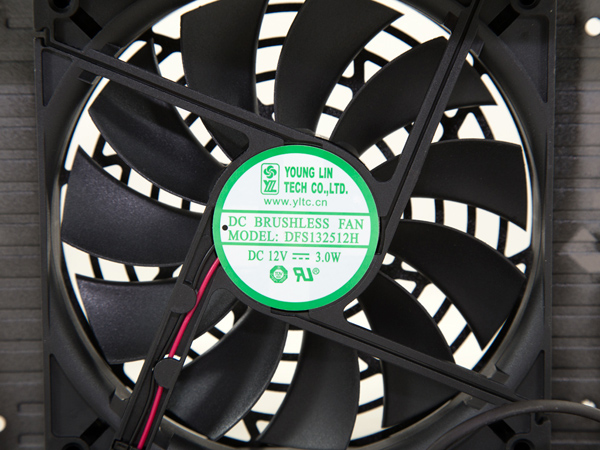Rosewill Quark 1000 Power Supply Review
Today we take a look at Rosewill's Quark 1000. In addition to 80 PLUS Platinum efficiency and fully modular cabling, this $200 unit can support multiple GPUs.
Why you can trust Tom's Hardware
A Look Inside And Component Analysis
Our main tools for disassembling PSUs are a Thermaltronics soldering and rework station and a Hakko 808 desoldering gun.
| Primary Side | |
|---|---|
| OEM | Enhance Electronics |
| Transient Filter | 4x Y caps, 4x X caps, 2x CM chokes, 1x MOV, 1x CM02X |
| Inrush Protection | NTC Thermistor |
| Bridge Rectifier(s) | 2x |
| APFC MOSFETs | 2x Infineon IPP50R140CP (550V, 15A @ 100 °C, 0.14mΩ ) |
| APFC Boost Diode | 1x CREE C3D10060G (600V, 10A @ 152 °C) |
| Hold-up Cap(s) | 2x Nippon Chemi-Con KMR series (450V, 390uF each or 780uF combined, 2000h @ 105 °C) |
| Main Switchers | 4x Infineon IPP50R190CE (550V, 11.7A @ 100 °C, 0.19mΩ) |
| APFC Controller | Champion CM6502TX |
| Switching Controller | Champion CM6901 |
| Topology | Primary side: Full-Bridge & LLC Resonant Converter Secondary side: Synchronous Rectification & DC-DC converters |
| Secondary Side | |
| +12V MOSFETs | 8x International Rectifier IRFH7004PbF (40V, 164A @ 100 °C, 1.4mΩ) |
| 5V & 3.3V | DC-DC Converters: 2x 86350D MOSFETs2x APW7073 PWM Controllers |
| Filtering Capacitors | Electrolytics: Nippon Chemi-Con (105 °C, KZH), Rubycon (105 °C)Polymers: Teapo, Duratech |
| Supervisor IC | SITI PS223 (OVP, UVP, OCP, SCP, OTP ) |
| Fan Model | Young Lin Tech DFS132512H (135mm, 12V, 3W, 1820 RPM, 91.16CFM) |
| 5VSB Circuit | |
| Rectifying Diode | 1x PFR10V45CT |
| Standby PWM Controller | STR-A6069H |




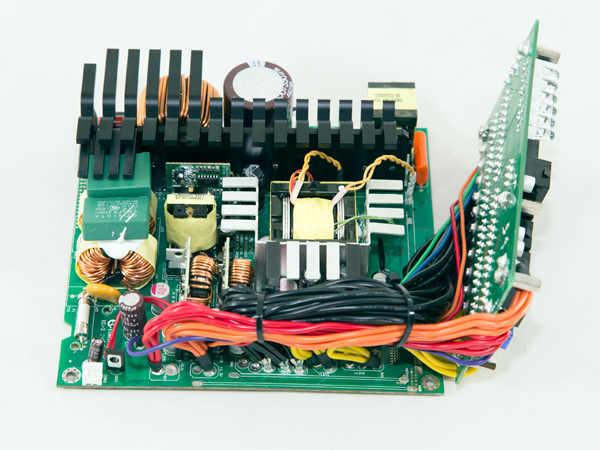

Rosewill's Quark PSU is made by Enhance Electronics--a good OEM, but one we don't often encounter in our reviews. The platform is definitely cutting-edge, with an LLC resonant converter on the primary side and synchronous rectification (SR) and DC-DC converters on the secondary side. Also, all of its electrolytic capacitors are made by Japanese manufacturers. In addition, a massive heat sink cools down the APFC converter's switchers along with the primary switchers. This heat sink will surely lighten the load of the cooling fan, at least on the primary side.







At the AC receptacle, two X caps and a pair of Y caps form the first part of the EMI filter, while on the main PCB we find two more pairs of X and Y caps along with a couple of CM chokes and an MOV. There is also a CM02X IC on the solder side of the main PCB, which is responsible for blocking the current through an X cap's discharge resistor when AC voltage is connected. In addition, the bridge rectifiers are installed between the enormous primary heat sink and a much smaller heat sink. Close to them is a sizable NTC thermistor that provides protection against large inrush currents. A relay bypasses this thermistor once the APFC caps are fully charged in order to provide higher efficiency.



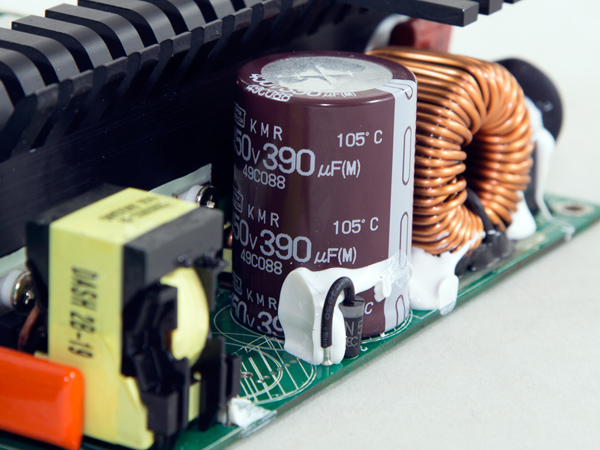


In the APFC converter, two Infineon IPP50R140CP FETs are used along with a single CREE C3D10060G boost diode. The pair of bulk caps is made by Nippon Chemi-Con (450V, 390uF each, or 780uF combined, 2000h @ 105 °C). We believe that their combined capacity is on the low side, so they won't be able to provide the hold-up time that’s defined by the ATX spec. The APFC controller is a Champion CM6502, which is most likely supported by a CM03X Green PFC controller.








There are four main switchers (Infineon IPP50R190CE) that (we believe) are arranged into a full-bridge topology. The LLC resonant controller is a Champion CM6901 IC, which operates the main switchers at PWM mode with light loads, while at higher loads it uses FM modulation. The main transformer is pretty small for a unit of this capacity and it's nearly surrounded by three heat sinks that have nothing bolted on them; these heat sinks play a key role since they dissipate heat from the MOSFETs underneath them. These MOSFETs (8x International Rectifier IRFH7004PbF) regulate the +12V rail and, in addition to the above heat sinks, are also cooled by the PSU's chassis through a thick thermal pad. Finally, two thermistors are attached to the fins of one of the +12V sinks with the help of heat-shrinks. One of them provides data to the fan control circuit, while the other one is used by OTP (Over-Temperature Protection).
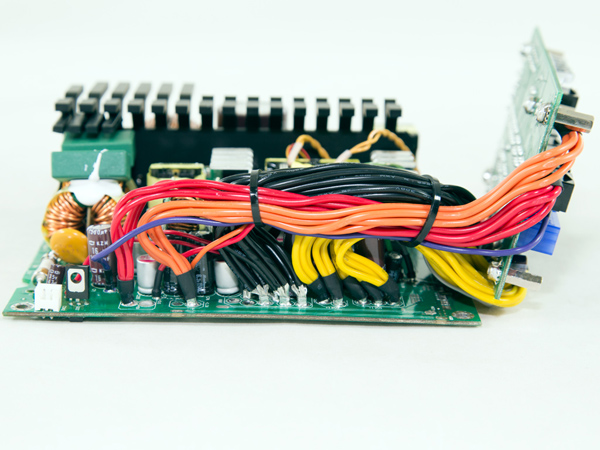
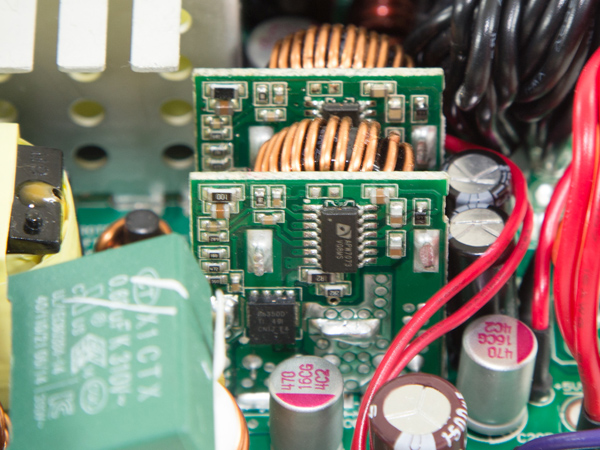
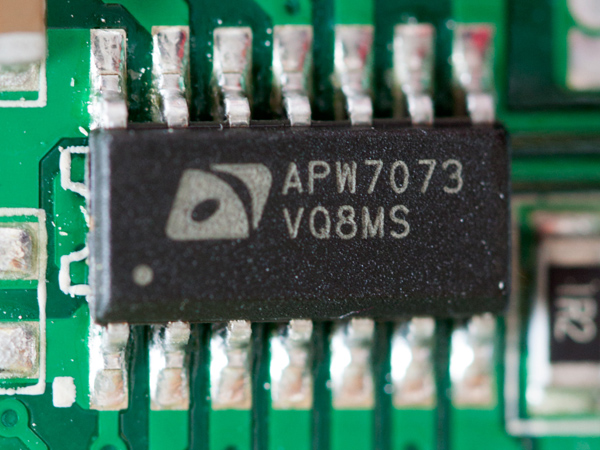




On the secondary side, two DC-DC converters generate the minor rails through +12V. An Anpec APW7073 PWM controller is used on each converter, along with a single 86350D MOSFET. On the secondary side, several high-quality electrolytic caps, provided by Rubycon and Chemi-Con, filter the rails along with some Teapo polymer caps.
The standby PWM controller is a STR-A6069H IC, and the SBR that rectifies the 5VSB rail, a PFR10V45CT, is right next to the 5VSB transformer.
Get Tom's Hardware's best news and in-depth reviews, straight to your inbox.
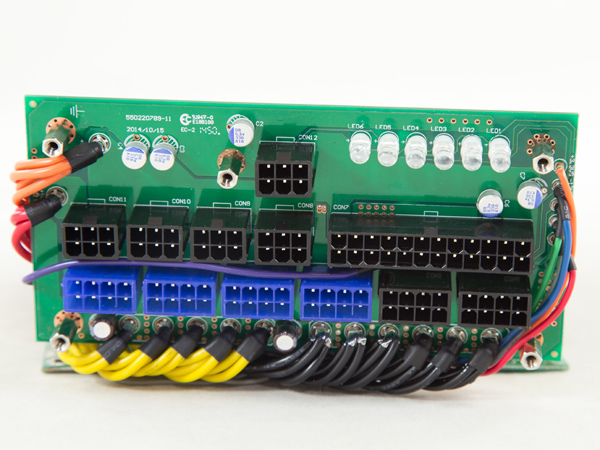

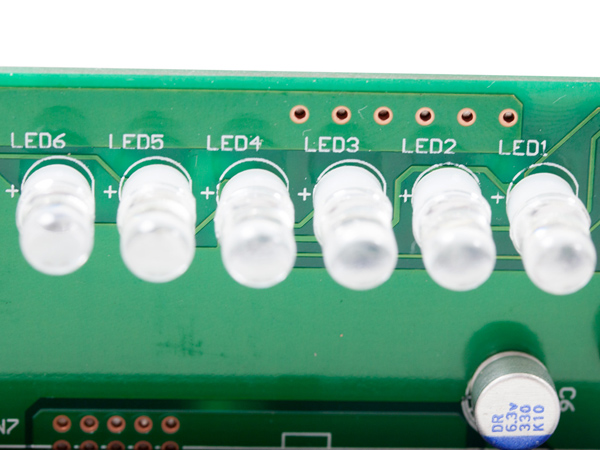

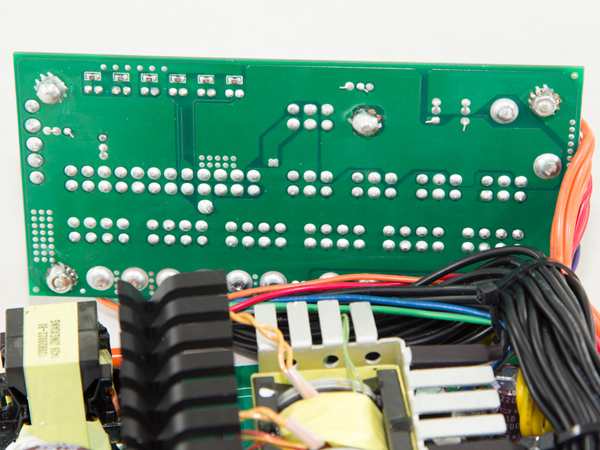
At the front side of the modular PCB, some polymer Duratech caps, along with two small electrolytic Chemi-Con caps, provide extra ripple filtering. On the back of the same board, the soldering quality is very good.










The main PCB also features solid soldering quality. All component leads are carefully trimmed, too. Enhance Electronics did an excellent job here.
Besides the supervisor IC (SITI PS223), which supports OTP out of the box, we found several other interesting components on the main PCB, including a pair of Lite-On optocouplers, two Silicon Labs Si8230BD gate drivers and four shunt resistors under the +12V islands. This is an indication that with the proper modifications (since the PS223 supports OCP for up to two +12V rails) this platform can support OCP for up to four virtual +12V rails.
The cooling fan is made by Young Lin Tech and its model number is DFS132512H (135mm, 12V, 3W, 1820RPM, 91.16 CFM). It uses a Riffle bearing, so it will last for quite a long time. However, it is quite noisy at higher speeds and the fan profile isn't as relaxed as we expected it to be, given this unit's high efficiency and large heat sinks.
Current page: A Look Inside And Component Analysis
Prev Page Packaging, Contents, Exterior And Cabling Next Page Load Regulation, Hold-Up Time And Inrush Current
Aris Mpitziopoulos is a contributing editor at Tom's Hardware, covering PSUs.
-
ern88 I don't know of Rosewill is any better then it was a few years ago. I had friends with a rosewill PSU and it baked big time. Maybe they are better now. But I would stick with EVGA or another well known good company!!!Reply -
justaguywithagun i wouldnt hesitate to replace my ~7y/o antec TP750 with a nice rosewill capstone unit when the time comes. in fact, thats essentially my plan. would i throw any rosewill unit in my rig/s? no i wouldnt, but every manufacturer i can think of has units that are less than desirable. rosewill has a come a long long way the last few yearsReply -
Larry Litmanen ReplyI don't know of Rosewill is any better then it was a few years ago. I had friends with a rosewill PSU and it baked big time. Maybe they are better now. But I would stick with EVGA or another well known good company!!!
Obviously EVGA has amazing brand name and they deserve it because of their level of service. However as far as i know EVGA does not have any PSU making plants, they simply rebrand a unit made by Seaconic or another OEM. Many companies do that, so you can probably buy exactly the same unit from a different brand.
I am not sure if Rosewill builds or rebrands, but i had their products and they are not bad, i personally have not had any issues. -
Aris_Mp Several Rosewill PSUs are build by Super Flower, the same OEM that also makes most of EVGA's offerings.Reply -
none12345 "I don't know of Rosewill is any better then it was a few years ago. I had friends with a rosewill PSU and it baked big time. Maybe they are better now. But I would stick with EVGA or another well known good company!!! "Reply
I duno if their large ones are as good. But ive had a 550 watt running in this computer for 6.5 years now with no problem. This is the first roswell one i had tried. Thats the longest ive ever stayed on the same power supply.(In the past it was either fry, or had to upgrade the size because of ever increasing component power usage) -
Aris_Mp Like every company that wants to do well into this market Rosewill doesn't rely on only one manufacturer. They had strong ties with Super Flower in the past however they decided to go with other OEMs as well, since SF became so popular and cannot meet the demands of all the companies that want their products.Reply -
Shalmaneser Does anyone actually do OCP, OVP, OPP / OLP, OTP, UVP, SCP, andReply
NLO? (Something of a rhetorical question), short answer from google is no...
Also, why is the list graphical? I'd like to have a character list to search through...

